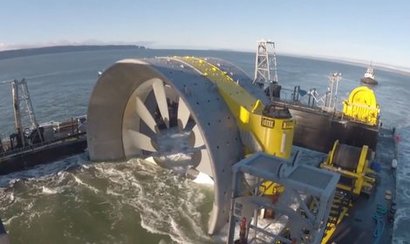
Cape Sharp Tidal, a partnership between Emera and OpenHydro/DCNS, deployed its 2 MW turbine two weeks ago at the Fundy Ocean Research Center for Energy (FORCE) test site near Parrsboro. This milestone marks a turning point for Canada’s renewable energy sector. It is the first time clean, renewable in-stream tidal power has successfully been generated from the Bay of Fundy, and the first time a turbine has been grid-connected at FORCE.
“This is a small but historic step in Nova Scotia’s transformation from using imported coal to becoming a leader in clean, local energy” said Tony Wright, general manager of FORCE. “This achievement is the result of many people working to make all aspects of this project fit together – from environmental approvals to subsea cables to grid connection. How far can in-stream tidal grow? Now the most important research
begins.”
Canadian Minister of Energy Michel Samson added that the deployment is a proud, and historic moment in Nova Scotia’s global leadership in the responsible development of a new and renewable energy source. The first in-stream tidal energy connection to the Canadian grid ushers in a new era in marine renewable energy, taking an unprecedented step toward a lower carbon future.
The demonstration open-centre turbine, designed and manufactured by OpenHydro, uses a fraction of the estimated 7,000 MW potential of the Minas Passage to power the equivalent of about 500 Nova Scotia homes with energy from tides. A second turbine, planned for deployment in 2017, will make Cape Sharp Tidal one of the largest generating arrays in the world.
The completed 4 MW demonstration project will displace the need to burn about 2,000 tonnes of coal, and eliminate 6,000 tonnes of greenhouse gas emissions, the equivalent of taking 1,000 cars off the road each year. This achievement contributes to Nova Scotia’s overachievement on national greenhouse gas reduction goals.
FORCE has invested $30 million in onshore and offshore electrical infrastructure to allow demonstration turbines to connect to the power grid. In total, more than 125 organisations contributed to the creation of the FORCE facility and its research and monitoring programs. More than 90 per cent of those are from Nova Scotia.
Cape Sharp Tidal has invested tens of millions of dollars to develop the local tidal industry and supply chain, and has met its commitment to spend 70 per cent of first-phase project costs in Nova Scotia. More than 300 people have been employed on the project in areas such as fabrication, environmental monitoring, engineering, health and safety, marine services and more. Nova Scotia’s tidal energy industry has the potential to create up to 22,000 jobs and contribute as much $1.7 billion to the economy.
This year, FORCE has collected additional data on sound, and on fish and marine mammals. This work will complement additional fish, lobster, marine mammal, seabird and noise studies at FORCE. Monitoring reports will be shared with regulators and the public, and will contribute to a growing international body of research.
Monitoring at other tidal sites around the world has not observed a single collision between ocean life and turbines in a marine environment. Nova Scotia will now have the opportunity to test these findings in the Minas Passage.
For additional information:

